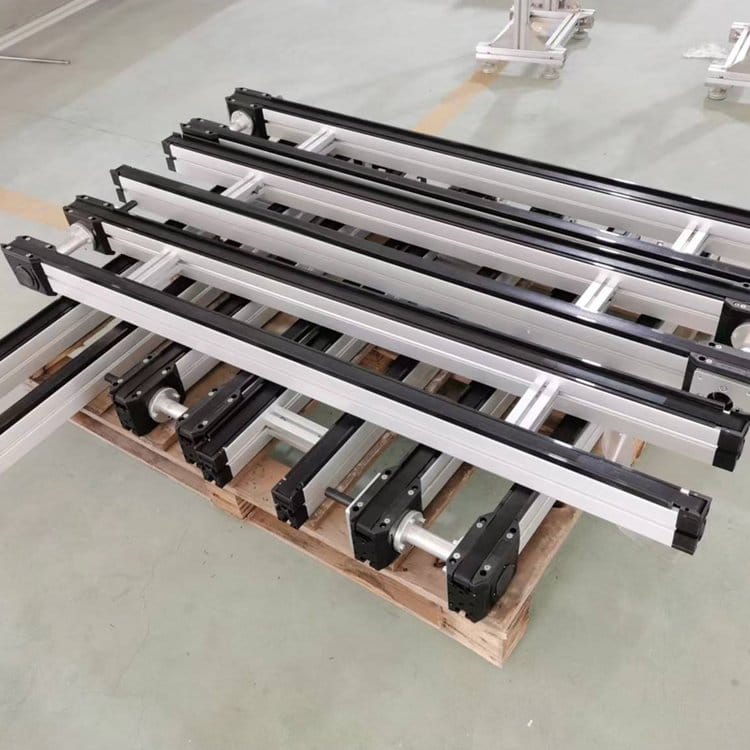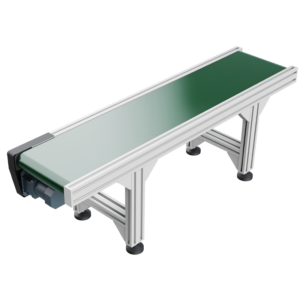Timing Belt Conveyors are a highly efficient and precise material handling solution designed to transport a wide range of products, comprese le scatole, sacchi, and parts, across various industrial settings. Featuring a robust timing belt system, this conveyor ensures smooth, stable, and synchronized movement of items. So that will make it ideal for applications requiring high-speed and accurate transport.
Its customizable design allows for easy adaptation to meet specific production needs, enhancing overall productivity.
Descrizione
Toshine Electrical Motors Trasportatore a cinghia dentata
Timing Belt Conveyors: A Simple Overview
Timing belt conveyors are great for moving workpieces or products with a rigid structure in a repetitive cycle. So these conveyors come in different drive options and can be set up as single, dual, or multi-line systems. Thus, they’re commonly used in building complex transportation solutions.
Dual-Line Solutions: The dual-line system is often used for transporting workpiece carriers. Oltretutto, timing belt conveyors are perfect when you need high speeds and fast acceleration. So for heavy loads, chain conveyors or accumulating roller chain conveyors are a better choice.

Technical Specifications:
- Widths: 160–1200 mm
- Lengths: 400–6000 mm
- Maximum Load: Typically up to 60 kg
- Speed: Up to 20 m/min
- Options: Single-line or multiple-line
- (Other specifications available upon request)
Our wide variety of timing belt materials helps you choose the best grip for your workpieces. Oltretutto, we offer options like aluminum timing belt pulleys, anodized pulleys, and stainless steel pulleys (which are more durable and resistant to corrosion).
Key Features of Timing Belt Conveyors:
- Perfect for transporting workpieces or products with a rigid structure in a repeating cycle.
- The drive pulley and timing belt are tightly connected. So that will ensure precise positioning and synchronization of the system.
- Different surface coatings on the timing belt give you the best grip for your specific needs.
- They run quietly and smoothly. Oltretutto, it is at high speeds and accelerations.
- Ideal for continuous, cycling operations.
- Low friction and excellent wear resistance for longer-lasting performance.
- The timing belt recirculates inside the profiles to reduce the risk of accidents.
- Compatible with workpiece carriers, lift-and-transfer modules, stoppers, positioning units, rotating units, and control components.
- System slots (10 mm wide) for adding stands, sponde laterali, and stoppers.
- This system can be the foundation for building complex workpiece transport systems.
- By using these conveyors, you can easily set up reliable and efficient transport solutions for your products.
Functions of a Timing Belt Conveyor
- Transporting Items: It moves a variety of items, such as boxes, sacchi, and parts, efficiently along the production line.
- Automation in Production: In industrial settings, the conveyor automatically transfers items. So it improves efficiency and cuts labor costs.
- Controlling Speed: Oltretutto, the speed of the conveyor can be adjusted to meet specific production needs.
- Safe Transport: The timing belt helps keep items stable during transport, reducing the risk of damage or loss.
Applications of Timing Belt Conveyors
- Industrial Production Lines: People use them widely in industries such as automobile manufacturing, elettronica, and food processing to move parts and finished products.
- Logistics and Warehousing: These conveyors help improve efficiency in the automatic transport and sorting of goods.
- Parcel Sorting in Express Logistics: Used in the logistics industry to automatically sort and transfer parcels.
- Airport Baggage Handling: Commonly used in airports to move baggage efficiently, automating the transfer process.
Installation of a Timing Belt Conveyor
- Preparazione: Choose the installation site carefully. Ensure there’s enough space and a solid structure to support the conveyor. Oltretutto, clean the area and make sure the ground is level.
- Install the Bracket: Securely install the conveyor bracket according to the manufacturer’s instructions to ensure stability.
- Install the Timing Belt: Attach the timing belt to the drive wheel and tension wheel. Make sure the belt is neither too tight nor too loose.
- Connect the Power: Plug in the power supply. So that will ensure it meets all safety standards.
- Testing: After installation, run a test to check that the conveyor works smoothly without any strange noises or vibrations.
Conclusion
Timing belt conveyors are powerful, versatile machines that boost production and logistics efficiency. For proper installation, they always follow the manufacturer’s guidelines to ensure safe and effective setup. Please take care during installation to avoid any accidents or errors.
Ready to streamline your production and boost efficiency? So contact us today to learn more about how our timing belt conveyors can help improve your operations. Whether you’re moving parts, products, or parcels, our customizable solutions are designed to meet your specific needs. Let’s work together to optimize your workflow and take your business to the next level. Get in touch now for a consultation!





